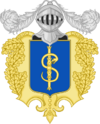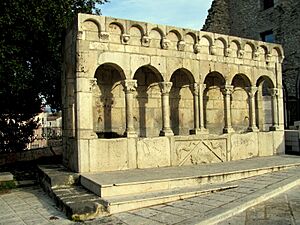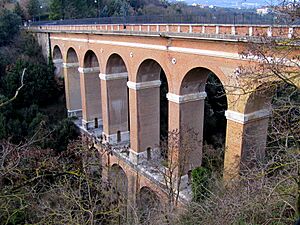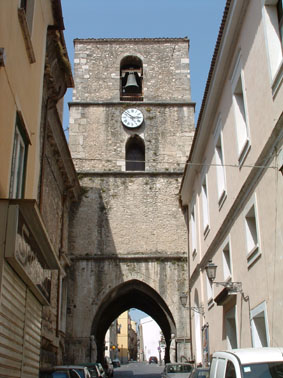Isernia facts for kids
Quick facts for kids
Isernia
Sèrnia
|
|||
|---|---|---|---|
| Città di Isernia | |||

Top left: Landscape of Isernia, Top right: "Corso Marcelli" Street, Bottom left: Fontana Fraterna, Bottom right: "San Pietro" Cathedral
|
|||
|
|||
| Country | Italy | ||
| Region | Molise | ||
| Province | Isernia (IS) | ||
| Frazioni | Acquazolfa, Bazzoffie, Breccelle, Capruccia, Castagna, Castelromano, Colle de' Cioffi, Colle Martino, Colle Pagano, Collecroci, Conocchia, Coppolicchio, Fragnete, Marini, Salietto, Valgianese | ||
| Area | |||
| • Total | 68.74 km2 (26.54 sq mi) | ||
| Elevation | 423 m (1,388 ft) | ||
| Population
(31 September 2021)
|
|||
| • Total | 20,863 | ||
| • Density | 303.506/km2 (786.08/sq mi) | ||
| Demonym(s) | Isernini | ||
| Time zone | UTC+1 (CET) | ||
| • Summer (DST) | UTC+2 (CEST) | ||
| Postal code |
86170
|
||
| Dialing code | 0865 | ||
| Patron saint | Pope Celestine V | ||
| Saint day | May 19 | ||
Isernia is a town in the southern Italian region of Molise. It is also the capital city of the province of Isernia. The town was once known by its Roman name, Aesernia.
Contents
Exploring Isernia's Location
Isernia is located on a rocky ridge. This ridge rises between 350 and 475 meters (1,150 to 1,560 feet) high. Two rivers, the Carpino and the Sordo, flow nearby.
The town's design still looks like an ancient Roman city. It has a main wide street, called Corso Marcelli. Smaller streets branch off at right angles from this central road.
Isernia includes 16 smaller areas called frazioni. The most populated one is Castelromano. It sits in a flat area at the base of Mount La Romana. This mountain is 862 meters (2,828 feet) high. Castelromano is about 5 kilometers (3 miles) from Isernia.
A Look at Isernia's Past
The area around Isernia has been home to people for a very long time. Scientists believe people lived here at least 700,000 years ago. A nearby place called Pineta is famous. It is one of the oldest sites where humans used fire. This discovery was even mentioned in the magazine Science.
Isernia in Ancient Times
The Roman name for the city was Aesernia. It was a city of the Samnites, an ancient Italian people. It was located in a valley near the Volturno River.
Isernia was first mentioned in history in 295 BC. By then, the Romans had already taken control of the area. In 264 BC, the Romans established a colony here. This made Isernia an important link between southern Italy and the mountains.
During the Second Punic War (209 BC), Isernia was one of the few cities that stayed loyal to Rome. Later, during the Social War, Isernia fought alongside Rome. It was bravely defended against the Samnite army. Even after a long siege, the city had to surrender due to lack of food in 90 BC.
Isernia became an important base for the Italic League during this war. However, it was severely damaged by the Roman general Sulla in 88 BC. After this, it became almost deserted for a time.
Isernia Through the Centuries
Later, new colonies were sent to Isernia by Julius Caesar and Augustus. But these were not very successful. So, another colony was established under Emperor Nero.
Isernia became an important town during the time of Emperors Trajan and the Antonines. From this period, parts of an ancient Roman aqueduct and a Roman bridge can still be seen. The lower parts of the modern city walls also show ancient stone work. The main church, Isernia Cathedral, stands on the base of an old Roman temple.
In the early 600s AD, a group of Bulgars settled in Isernia. They were seeking safety from other groups. These Bulgars were a distinct part of the population for many generations.
Isernia has faced destruction many times throughout history.
- In 800, the Saracens destroyed it.
- In 1199, it was attacked by Markward of Anweiler.
- In 1223, soldiers of Frederick II set it on fire.
- In 1519, Charles V, Holy Roman Emperor freed it from feudal rule. It then became a city in the Kingdom of Naples.
Major earthquakes also caused great damage in 847, 1349, 1456, and 1805.
Isernia in Modern Times
During World War II, on September 10, 1943, American planes bombed Isernia. It was a market day, and the town was crowded. This tragic event caused many deaths. Over the next few weeks, planes returned twelve more times. They were trying to hit bridges vital for the German army's retreat. However, they never hit their targets.
In 1970, Isernia became the capital of its own province. This new province was created from part of the province of Campobasso.
Isernia's Economy
The hills around Isernia are known for producing wine. They make red, white, and rose Pentro di Isernia wine. This is a special Italian DOC wine.
Isernia's Old Coins
Ancient coins from Aesernia have been found. They are made of copper and say "AISERNINO". These coins were made during the time of the first Roman colony. Their style shows the influence of the nearby region of Campania.
Main Places to See in Isernia
Even after being destroyed many times, Isernia still has many ancient ruins. The old city center still has the layout of a Roman town. The main street, Corso Marcelli, is still there. Many small alleys and squares branch off from it.
The famous Fraterna Fountain is a main symbol of the town. It was built in the 13th century. It uses stone slabs from old Roman buildings. The rest of the fountain was made by local craftspeople.
Religious Buildings
- Isernia Cathedral of San Pietro
- Santa Maria delle Monache
- San Francesco
- Santa Chiara
- Santi Cosma e Damiano
- Chiesa della Concezione
- San Pietro Celestino
- San Giuseppe lavoratore
- Santa Maria Assunta
The Fraterna Fountain
The “Fontana Fraterna” is a beautiful public fountain. It has six water jets and looks like an arcade. It is made from strong limestone blocks. The fountain uses materials from Roman and Romanesque times. It was restored in 1835.
The fountain has three layers of stone. The bottom layer has smooth stones. One stone on the left has a Roman writing on it. In the middle, there is a stone decorated with dolphins and a Roman flower. This piece likely came from an old tomb.
The middle layer has six round arches. These arches are supported by small columns. On the left, the columns are round. On the right, they are eight-sided.
Above these columns are old capitals (the tops of columns) that were reused. The top layer has smooth stones. On these, twelve small hanging arches are set. They are supported by small brackets. These brackets are decorated with animals, plants, and geometric shapes.
At the bottom of the fountain, behind the arches, are two Roman-era blocks. They have decorations and a tomb inscription. On the right side, there is a medieval inscription. It is placed between two lion statues. This inscription talks about the fountain being built.
Studying the fountain shows that its blocks were worked on many times. This happened over a very long period. The stones came from different buildings in the town. The fountain is like a history book made of stone. It shows centuries of the town's story.
The Pineta Archaeological Site
Isernia La Pineta is an important archaeological site. It covers about 20,000 square meters (5 acres). Thousands of bones and stone tools have been found here.
The site was discovered in 1979 by a nature lover. He saw a bone sticking out of the ground. This happened during the building of the Napoli-Vasto motorway. It is clear that humans created this site. However, its exact purpose is still a mystery.
See also
 In Spanish: Isernia para niños
In Spanish: Isernia para niños






